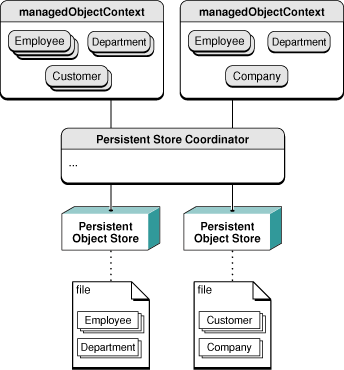一、基础概念深入
1.NSManagedObjectContext
被管理数据上下文就像便笺簿
当从数据持久层获取数据时,相当于把这些临时的数据拷贝写在便笺簿上,然后就可以随心所欲的修改这些值。
通过上下文,可以对数据记录NSManagedObject进行添加删除更改,记录更改后支持撤销和重做。
除非你保存这些数据变化,否则持久层的东西是不会变化。
通常我们将 controller 类或其子类与 Managed Object Context NSManagedObjectContext绑定,这样就方便我们动态地生成,获取数据对象等。
常用的方法:
| -save: | 将数据对象保存到数据文件 |
| -objectWithID: | 查询指定 Managed Object ID 的数据对象 |
| -deleteObject: | 将一个数据对象标记为删除,但是要等到 Context 提交更改时才真正删除数据对象 |
| -undo | 回滚最后一步操作,这是都 undo/redo 的支持 |
| -lock | 加锁,常用于多线程以及创建事务。同类接口还有:-unlock and -tryLock |
| -rollback | 还原数据文件内容 |
| -reset | 清除缓存的 Managed Objects。只应当在添加或删除 Persistent Stores 时使用 |
| -undoManager | 返回当前 Context 所使用的 NSUndoManager |
| -assignObject: toPersistantStore: | 由于 Context 可以管理从不同数据文件而来的数据对象, 这个接口的作用就是指定数据对象的存储数据文件(通过指定 PersistantStore 实现) |
| -executeFetchRequest: error: | 执行获取数据请求,返回所有匹配的数据对象 |
2.NSManagedObject
被管理的数据记录,相当于数据库中的一条记录
每一个NSManagedObject对象,都有一个全局 ID(类型为:NSManagedObjectID)。每个在NSManagedObjectContext注册过
的NSManagedObject,可以通过这个全局 ID 在上下文中查询到。
每个在持久存储层中的对象,都对应一个与上下文相关的NSManagedObject
常用的方法:
-entity 获取实体
-objectID 获取NSManagedObjectID
-valueForKey: 获取指定 Property 的值
-setValue: forKey: 设定指定 Property 的值
3.NSFetchRequest
获取数据的请求,通过被管理数据的上下文来执行查询,比如
NSArray *fetchedObjects = [context executeFetchRequest:fetchRequest error:&error];
查询时,必须指定查询实体或实体名称,以 NSArray 形式返回查询结果,如果我们没有设置任何查询条件,则返回该 Entity 的所有数据对象。
我们可以使用谓词来设置查询条件,通常会将常用的 Fetch Requests 保存到 dictionary 以重复利用。
NSFetchRequest包括以下部分:
(1)实体(Entity)的名称
(2)NSPredicate谓词(搜索关键字或限定条件)
(3)排序方式(NSArray *)sortDescriptors
所有的被管理对象(managed object)都必须在上下文中注册,而通过NSFetchRequest获得的对象自动被注册。
如果在上下文中已经存在了要获取的对象,那么这个被管理NSManagedObject将被返回。否则上下文就会从相关的数据源中查找(也可能找不到)
例如,以下代码是查询在指定日期之后创建的ContactInfo,并将查询结果按照name排序
NSManagedObjectContext * context = [self managedObjectContext]; NSManagedObjectModel * model = [self managedObjectModel]; NSDictionary * entities = [model entitiesByName]; NSEntityDescription * entity = [entities valueForKey:@"ContactInfo"]; NSPredicate * predicate; predicate = [NSPredicate predicateWithFormat:@"creationDate > %@", date]; NSSortDescriptor * sort = [[NSortDescriptor alloc] initWithKey:@"name"]; NSArray * sortDescriptors = [NSArray arrayWithObject: sort]; NSFetchRequest * fetch = [[NSFetchRequest alloc] init]; [fetch setEntity: entity]; [fetch setPredicate: predicate]; [fetch setSortDescriptors: sortDescriptors]; NSArray * results = [context executeFetchRequest:fetch error:nil]; [sort release]; [fetch release];
常用方法:
| -setEntity: | 设置你要查询的数据对象的类型(Entity) |
| -setPredicate: | 设置查询条件 |
| -setFetchLimit: | 设置最大查询对象数目 |
| -setSortDescriptors: | 设置查询结果的排序方法 |
| -setAffectedStores: | 设置可以在哪些数据存储中查询 |
4.NSPersistentStoreCoordinator
持久化数据助理
Core Data定义了一个栈,持久化存储助理在中间,栈顶是被管理数据的上下文,栈底是持久化存储层,结构如图
通常从磁盘上的数据文件中读取或存储数据,这些底层的读写就由它来处理。一般我们无需与它直接打交道,上下文已经封装了对它的调用
常用方法:
| -addPersistentStoreForURL:configuration:URL:options:error: | 加载持久化存储数据,对应的卸载接口为 -removePersistentStore:error: |
| -migratePersistentStore:toURL:options:withType:error: | 迁移数据存储,效果与 "save as"相似,但是操作成功后, 迁移前的数据存储不可再使用 |
| -managedObjectIDForURIRepresentation: | 返回给定 URL所指示的数据存储的 object id,如果找不到匹配的数据存储则返回 nil |
| -persistentStoreForURL: | 返回指定路径的 Persistent Store |
| -URLForPersistentStore: | 返回指定 Persistent Store 的存储路径 |
5.NSManagedObjectModel
被管理的数据模型,用来描述程序的实体、其属性、关系的模型图
包括以下几个部分:
(1)实体(Entity)
对应NSEntityDescription对象
相当于数据库中的一个表
实体名称(name)
实体类名:NSManagedObject子类的名称
实体实例:NSManagedObject对象或其子类的实例
NSEntityDescription 常用方法:
+insertNewObjectForEntityForName:inManagedObjectContext: 工厂方法,
根据给定的 Entity 描述,生成相应的 NSManagedObject 对象,并插入 ManagedObjectContext 中。
-managedObjectClassName返回映射到 Entity 的 NSManagedObject 类名
-attributesByName以名字为 key, 返回 Entity 中对应的 Attributes
-relationshipsByName以名字为 key, 返回 Entity 中对应的 Relationships
(2)属性(Property)
对应NSPropertyDescription对象
Property 为 Entity 的特性,它相当于数据库表中的一列,或者 XML 文件中的 value-key 对中的 key。
它可以描述实体基本属性(Attribute),实体之间的关系(RelationShip),或查询属性(Fetched Property)。
<1> 实体的基本属性(Attributes)
对应NSAttributeDescription对象
存储基本数据,数据类型包括:
string,date,integer(NSString, NSDate, NSNumber)
<2> 实体间的关系(Relationships)
对应NSRelationshipDescription对象
支持对一、对多的关系
<3> 查询属性(Fetched Property)
对应NSFetchedPropertyDescription对象
根据查询谓词返回指定实体的符合条件的数据对象
表示了一种“弱”的、单项的关系(相当于数据库中的查询语句)
6.持久化存储层(Persistent Stores)
持久化存储层是和文件或外部数据库关联的,大多数访问持久化存储层的动作都由上下文来完成。
7.NSFetchedResultsController
用于在表视图table view中加载部分数据
二、用代码创建数据模型
NSManagedObjectModel *managedObjectModel()
{ static NSManagedObjectModel *moModel = nil; if (moModel != nil) { return moModel;
}
moModel = [[NSManagedObjectModel alloc] init];
// Create the entity NSEntityDescription *runEntity = [[NSEntityDescription alloc] init];
[runEntity setName:@"Run"];
[runEntity setManagedObjectClassName:@"Run"];
[moModel setEntities:[NSArray arrayWithObject:runEntity]];
// Add the Attributes NSAttributeDescription *dateAttribute = [[NSAttributeDescription alloc] init];
[dateAttribute setName:@"date"];
[dateAttribute setAttributeType:NSDateAttributeType];
[dateAttribute setOptional:NO];
NSAttributeDescription *idAttribute = [[NSAttributeDescription alloc] init];
[idAttribute setName:@"processID"];
[idAttribute setAttributeType:NSInteger32AttributeType];
[idAttribute setOptional:NO];
[idAttribute setDefaultValue:[NSNumber numberWithInteger:-1]]; // Create the validation predicate for the process ID. // The following code is equivalent to validationPredicate = [NSPredicate predicateWithFormat:@"SELF > 0"] NSExpression *lhs = [NSExpression expressionForEvaluatedObject];
NSExpression *rhs = [NSExpression expressionForConstantValue:[NSNumber numberWithInteger:0]];
NSPredicate *validationPredicate = [NSComparisonPredicate
predicateWithLeftExpression:lhs
rightExpression:rhs
modifier:NSDirectPredicateModifier
type:NSGreaterThanPredicateOperatorType
options:0];
NSString *validationWarning = @"Process ID < 1";
[idAttribute setValidationPredicates:[NSArray arrayWithObject:validationPredicate]
withValidationWarnings:[NSArray arrayWithObject:validationWarning]];
NSArray *properties = [NSArray arrayWithObjects: dateAttribute, idAttribute, nil];
[runEntity setProperties:properties];
// Add a Localization Dictionary NSMutableDictionary *localizationDictionary = [NSMutableDictionary dictionary];
[localizationDictionary setObject:@"Date" forKey:@"Property/date/Entity/Run"];
[localizationDictionary setObject:@"Process ID" forKey:@"Property/processID/Entity/Run"];
[localizationDictionary setObject:@"Process ID must not be less than 1" forKey:@"ErrorString/Process ID < 1"];
[moModel setLocalizationDictionary:localizationDictionary];
return moModel;
}
1)我们创建了一个全局模型 moModel;
2)并在其中创建一个名为 Run 的 Entity,这个 Entity 对应的 ManagedObject 类名为 Run(很快我们将创建这样一个类);
3)给 Run Entity 添加了两个必须的 Property:date 和 processID,分别表示运行时间以及进程 ID;并设置默认的进程 ID 为 -1;
4)给 processID 特性设置检验条件:必须大于 0;
5)给模型设置本地化描述词典;
本地化描述提供对 Entity,Property,Error信息等的便于理解的描述,其可用的键值对如下表:
| Key | Value |
| "Entity/NonLocalizedEntityName" | "LocalizedEntityName" |
| "Property/NonLocalizedPropertyName/Entity/EntityName" | "LocalizedPropertyName" |
| "Property/NonLocalizedPropertyName" | "LocalizedPropertyName" |
| "ErrorString/NonLocalizedErrorString" | "LocalizedErrorString" |
三、存储数据到xml文件
存储类型为NSXMLStoreType
NSManagedObjectContext *managedObjectContext()
{ static NSManagedObjectContext *moContext = nil; if (moContext != nil) { return moContext;
}
moContext = [[NSManagedObjectContext alloc] init];
// Create a persistent store coordinator, then set the coordinator for the context. NSManagedObjectModel *moModel = managedObjectModel();
NSPersistentStoreCoordinator *coordinator = [[NSPersistentStoreCoordinator alloc] initWithManagedObjectModel:moModel];
[moContext setPersistentStoreCoordinator: coordinator];
// Create a new persistent store of the appropriate type. NSString *STORE_TYPE = NSXMLStoreType;
NSString *STORE_FILENAME = @"CoreDataTutorial.xml";
NSError *error = nil;
NSURL *url = [applicationDocmentDirectory() URLByAppendingPathComponent:STORE_FILENAME];
NSPersistentStore *newStore = [coordinator addPersistentStoreWithType:STORE_TYPE
configuration:nil
URL:url
options:nil
error:&error];
if (newStore == nil) {
NSLog(@"Store Configuration Failure
%@", ([error localizedDescription] != nil) ? [error localizedDescription] : @"Unknown Error");
} return moContext;
}
四、自定义NSManagedObject子类
比如,Run.h文件
#import <CoreData/NSManagedObject.h>@interface Run : NSManagedObject
{
NSInteger processID;
}
@property (retain) NSDate *date;
@property (retain) NSDate *primitiveDate;
@property NSInteger processID;@end
Run.m文件
- (= mark - mark Getter and setter -=- (=- ()setNilValueForKey:(NSString * ([key isEqualToString:=
1)这个类中的 date 和 primitiveDate 的访问属性为 @dynamic ,这表明在运行期会动态生成对应的 setter 和 getter;
2)在这里我们演示了如何正确地手动实现 processID 的 setter 和 getter:为了让 ManagedObjecContext 能够检测 processID的变化,以及自动支持 undo/redo,我们需要在访问和更改数据对象时告之系统,will/didAccessValueForKey 以及 will/didChangeValueForKey 就是起这个作用的。
3)当我们设置 nil 给数据对象 processID 时,我们可以在 setNilValueForKey 捕获这个情况,并将 processID 置 0;
4)当数据对象被插入到 ManagedObjectContext 时,我们在 awakeFromInsert 将时间设置为当前时间。
